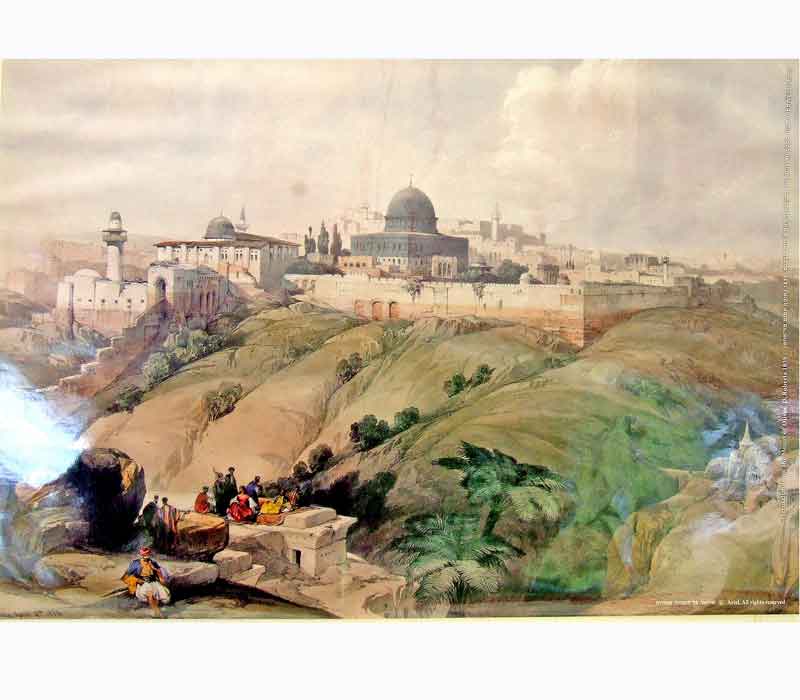 One of the many modern myths about Israel is that Jews were absent from the land from 70 AD until the late 19th century when Zionists came from Europe. In contrast, it is alleged, Palestinians have been on the land for more than 2000 years.
One of the many modern myths about Israel is that Jews were absent from the land from 70 AD until the late 19th century when Zionists came from Europe. In contrast, it is alleged, Palestinians have been on the land for more than 2000 years.
In a future post I will show that the second part of this is untrue, for Palestinians have had that identity only since 1967, and most of the current population comes from Arab and other immigrants in the 19th and 20th centuries.
This post will show that the first part is also untrue. In Reclaiming Israel’s History, David Brog demonstrates that Jews have been living on the land for more than 3000 years. For example, even after the Roman conquest of Jerusalem in 70 AD the Judean hillsides remained overwhelmingly Jewish, and as the second century dawned, the Jews were still a majority in their land.
Even after the Romans killed 580,000 Jews during the Bar Kochba revolt (132-35 AD), the Jews remained a majority on the land, and Galilee’s Jewish communities actually grew.
This was still true after a third Jewish revolt, this time against the Byzantine ruler Gallus in the 4th century. The Jews remained a majority in Galilee. This continued into the 5th century as the Jerusalem Talmud was written. This Talmud shows there were 205 villages in Galilee, 101 in the Jerusalem region, and 67 on the coastal plain and what is now Jordan.
When the Persians arrived in 614 Jews were able to muster a fighting force of 20,000 to help oust the Byzantines, who had reduced the Jews to 2nd-class citizens in their own land. But when the Persians double-crossed the Jews and made peace with the Byzantines, the latter reconquered Jerusalem and massacred most of its Jews. Yet when the Arabs conquered the land between 636 and 640, there was still a significant Jewish population. Caliph Omar permitted 70 Jewish families to return to their holy city and build a synagogue on the Temple Mount.
A little later Muslim persecution began. They built mosques on every major Jewish holy site, including the Temple Mount. Nevertheless, in the 10th century Jews still had a substantial presence, with over 50 Jewish towns and villages.
When the Crusaders conquered Jerusalem in 1099 most of its defenders were Jews. Jews defended Haifa. There were other Jewish cities such as Safed and Tiberias in Galilee.
In the first part of the 13th century 300 rabbis from England and France immigrated to Palestine, most settling in Jerusalem. Even though the Mamluk period (1250-1517) was humiliating for Jews, there were repeated waves of Jewish immigration from Spain, Italy, North Africa and Syria.
When Suleiman the Magnificent opened the Ottoman period (1517-1918), he warmly welcomed Jewish immigration. Students from around the world flocked to Safed to study under famous rabbis, and 3000 looms were manufacturing clothing shipped to Damascus, Constantinople, and beyond. Jews began to rebuilt Tiberias.
Then decline set in during the 18th century, when Jewish numbers dipped to between 6000 and 8000. Yet by the last quarter of the century immigration resumed, this time from Russia and Lithuania to Safed.
Palestine sank to rock bottom in the early 19th century, when Palestine as a whole only had 200,000 residents. As late as 1867 Mark Twain famously wrote that on his visit he found a “desolate” and “mournful” landscape that contained only a handful of people on his entire route.
Then suddenly, when the Ottomans buckled to European pressure and permitted foreign consulates in Jerusalem to protect their own citizens, Jews felt safer. Jewish immigration exploded. By 1840 there were 5000 Jews in Jerusalem alone. By 1882 there were another 2000 Jews living outside the city’s walls. Jews were a majority of the city’s population. In 1895 Jews numbered 30,000, roughly 60% of the city’s population.
“Thus by the time the modern Zionist movement was founded in 1897, a modern wave of Jewish immigration to Palestine had already been underway for decades. Zionism was not some dramatic rediscovery of Palestine after 2000 years. Zionism is merely the latest–and the most successful–of the long list of Jewish efforts to return to their homeland” over the last 2000 years. (Brog, 37)










